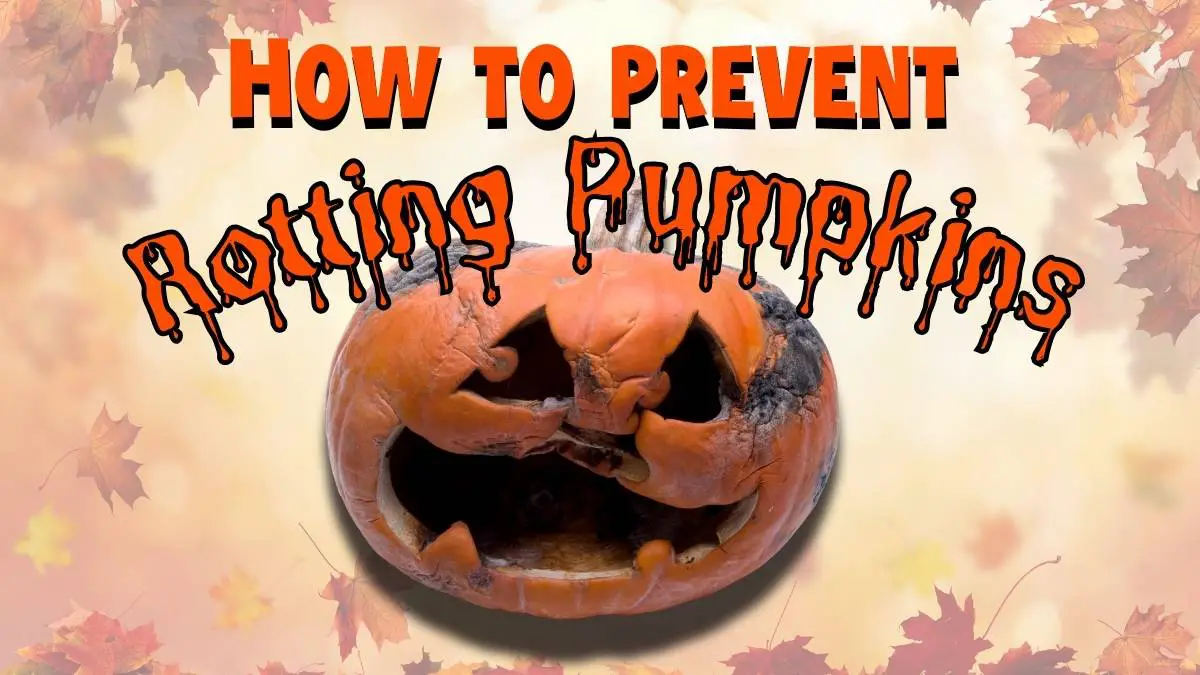Carving pumpkins is one of the highlights of Halloween, but nothing’s more disappointing than seeing your jack-o’-lantern turn into a mushy mess before the big night. Luckily, with a few simple tricks, you can keep your carved masterpiece looking fresh and spooky for longer.
Whether you’re looking to use everyday household items or natural alternatives, we’ve got a solution. Let’s make sure your Halloween decor stays frightfully fabulous!
Key Takeaways
- Start by selecting ones that feel firm and are free of blemishes.
- Scoop out every last bit of the insides, leaving no seeds or slimy strands behind.
- A mixture of water and bleach or a vinegar solution can sanitize your pumpkin, killing bacteria that prompt decay.
- Coat carved areas and the entire surface with petroleum jelly to seal in moisture and fend off mold.
- Store your pumpkins in a cool, dry place, far from direct sunlight or heat.
- Inspect pumpkins daily for soft spots or signs of decay and reapply preservation methods as needed.
Pick a Good Pumpkin
Pumpkin preservation starts with selecting a healthy pumpkin. When selecting a pumpkin, it’s crucial to pick one that’s firm and free of blemishes.
To pick a pumpkin that pumpkin lasts through the season, gently press on its skin. A good pumpkin should feel solid and resist pressure. Avoid any with soft spots or cracks, as these can be early signs of rot. Additionally, the stem should be sturdy and securely attached, which helps to preserve the pumpkin longer.
| Feature | What to Look For | Why It Matters |
|---|---|---|
| Firmness | Solid, no soft areas | Indicates health and longevity |
| Blemishes | Smooth, unblemished skin | Reduces chances of rotting |
| Stem | Sturdy and attached | Aids in preservation |
| Color | Deep, rich hues | Sign of a mature pumpkin |
Scoop Out the Pumpkin Guts and Clean
Nothing beats the satisfaction of scooping out the pumpkin guts and preparing it for carving. As you cut the top off your pumpkin, a sense of anticipation fills the air. With a sturdy spoon, you start to scrape the sides, freeing the pumpkin seeds and stringy fibers. This step is vital not just for the perfect jack-o-lantern but also to prevent early rotting.
To make sure you’ve done a thorough job, here’s what you need to do:
- Use paper towels:
- Get a clean spray bottle: Fill it with water and a tablespoon of bleach to sanitize.
- Spray the inside: Lightly mist the pumpkin’s interior to kill bacteria and fungi.
- Save the pumpkin seeds: Rinse and dry them for roasting later.
Once you’ve scooped out all the pumpkin guts, wipe down the inside with paper towels to remove excess moisture.
The next step is cleaning, and we’ve got a couple of options:
How to Preserve Pumpkins with Bleach
Preserving pumpkins with bleach is a simple yet effective method to extend their lifespan. Imagine your porch pumpkins staying fresh and vibrant for weeks, charming every passerby.
First, mix one tablespoon of bleach per gallon of water. This solution will help preserve pumpkins by killing off harmful bacteria and fungi that cause rot.
Dip a clean cloth or sponge into the bleach solution and gently wipe down your decorative pumpkins. Be thorough but gentle; you want to cover the entire surface without causing damage.
You can also pour this mixture into a spray bottle and generously spritz the inside and outside of your pumpkin. This helps kill off mold and bacteria, which are the main culprits behind premature rotting.
This deep cleansing guarantees that every nook and cranny is treated, offering maximum preservation.
After soaking, let your pumpkins dry completely before placing them back on display.
Why Bleach Works:
Bleach is a strong disinfectant that kills a wide range of microorganisms, including bacteria, mold, and fungi, which are the main culprits behind pumpkin decay. When you soak or spray a carved pumpkin with a bleach solution, you effectively sanitize the pumpkin’s surface. This disinfection slows down the decomposition process because the microorganisms that break down the pumpkin’s tissue are killed or inhibited by the bleach.
Bleach is a harsh chemical,and could also cause the pumpkin to dry out too quickly if not used carefully.
How to Preserve Pumpkins with Vinegar
Using vinegar can be an effective and natural way to keep your pumpkins from rotting. As October is here and you’re brainstorming pumpkin carving ideas, you’ll want your creations to last through Halloween.
Simply mix one part vinegar to ten parts water in a bucket. That’s about a cup of vinegar to a gallon of water. This mixture will help prevent mold and decay.
After you’ve cleaned your pumpkin as outlined above, submerge the pumpkin in the vinegar solution, ensuring it’s completely covered.
Let it soak for about 20-30 minutes. This step helps kill any bacteria that could cause early rotting. After soaking, remove the pumpkin and pat it dry with a towel.
Place your pumpkin in a cool, shaded area away from direct sunlight. Sunlight can accelerate the rotting process.
If you’re using real candles to light up your jack-o’-lantern, make sure to blow them out when not in use, as heat can also speed up decay. You can use LED candles instead to get the same effect without the heat.
Why Vinegar Works:
Vinegar, particularly white vinegar, is acidic, with a pH of around 2.5 to 3.5. This acidity creates an environment that’s inhospitable to many bacteria and fungi, similar to bleach (but less harsh.)
Soaking or spraying the pumpkin with a vinegar solution (a mix of one part vinegar to three parts water) helps to slow down microbial growth. While not as potent as bleach, vinegar is a more natural and less toxic option, making it appealing for those looking for an eco-friendly way to preserve their pumpkins. Also, vinegar doesn’t dry out the pumpkin as bleach might, which can help maintain its appearance for longer.
Have more science fun with vinegar
How to Preserve Pumpkins Naturally (without bleach)
If you’d rather avoid chemicals, there are natural methods to keep your pumpkins looking fresh.
Embracing these techniques can make your pumpkins decorations last longer, adding a touch of magic to your Halloween pumpkins carvings.
Start by soaking your pumpkins in an ice bath. Fill a large tub with cold water and add a generous amount of ice. Submerge your pumpkins completely for about an hour. The cold water helps to kill bacteria and fungi that can cause rot.
After the ice bath, mix a quart of water with a few drops of peppermint oil in a spray bottle. A goo mix would be 10-15 drops of oil per cup of water. Peppermint oil is a natural antifungal agent and smells nice as a bonus.
- Spray the peppermint mixture all over your pumpkins.
- Let the pumpkins air dry completely.
- Store them in a cool, dry place away from direct sunlight.
- Check them daily for any signs of mold or soft spots.
Why Peppermint Oil Works:
Peppermint oil contains compounds like menthol and menthone, which have natural antibacterial, antifungal, and antiviral properties. When applied to the surface of a carved pumpkin, peppermint oil can inhibit the growth of the bacteria, molds, and fungi that typically cause the pumpkin to decay.
This is similar to how bleach and vinegar work but with a more pleasant scent and without the harsh chemicals.
How to Preserve Pumpkins with Petroleum Jelly
Once you’ve scooped out and used one of the solutions above to kill bacteria, you can use petroleum jelly to seal the deal.
Grab some petroleum jelly and start applying a generous coat to the entire pumpkin all the carved edges and inner surfaces. This acts as a barrier, reducing the pumpkin’s exposure to air and moisture, which are the main culprits of rot.
- Use a clean cloth to apply the jelly evenly.
- Focus on the edges of the carvings, as they dry out the fastest.
- Reapply every few days to maintain the protective barrier.
- Store your pumpkin in a cool, dry place to prolong its freshness.
How Long Do Pumpkins Last?
Now that you know how to keep your carved pumpkin from rotting, you might wonder how long it will actually last.
The lifespan of pumpkins can significantly vary based on storage methods. Fresh pumpkins can last several months when kept in a cool, dry place, such as a basement or a well-ventilated area. Ideal conditions include temperatures between 50-60°F and low humidity, which help preserve their texture and flavor.
In contrast, carved pumpkins have a considerably shorter lifespan. Typically, a healthy pumpkin, once carved, can last about one to two weeks. This is due to the exposure of their inner flesh, which can quickly deteriorate and attract mold and bacteria after being cut.
More Pumpkins
Check our rotting pumpkin experiment to see what happens to pumpkins under different conditions, and click here for even more science activities with pumpkins!
Wrap Up – Making Carved Pumpkins Last Longer
As autumn’s golden hues fade and the crisp air turns brisk, your carved pumpkins can still sit proudly on your porch, defying the march of time. You’ve mastered the art of preserving your creations, using a number of methods and a bit of ingenuity.
The key to preserving pumpkins lies in keeping them away from moisture and bacteria.
To guarantee your carved pumpkin stays vibrant, inspect it daily for soft spots. These are telltale signs that decay has started.
If you find any, you can slow the process by spraying the affected area to kill bacteria and fungus, and applying a layer of petroleum jelly to seal the exposed edges.
Enjoy the season’s magic, knowing your pumpkins will glow a little longer, casting their merry light.
More Fall Fun
Don’t miss these other Fall science activities!




